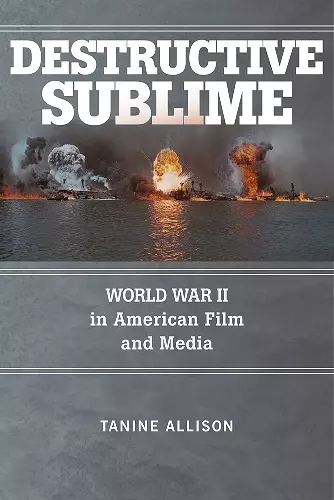Destructive Sublime
World War II in American Film and Media
Format:Hardback
Publisher:Rutgers University Press
Published:25th Jun '18
Currently unavailable, and unfortunately no date known when it will be back
This hardback is available in another edition too:
- Paperback£32.00(9780813597485)

The American popular imagination has long portrayed World War II as the “good war,” fought by the “greatest generation” for the sake of freedom and democracy. Yet, combat films and other war media complicate this conventional view by indulging in explosive displays of spectacular violence. Combat sequences, Tanine Allison argues, construct a counter-narrative of World War II by reminding viewers of the war’s harsh brutality.
Destructive Sublime traces a new aesthetic history of the World War II combat genre by looking back at it through the lens of contemporary video games like Call of Duty. Allison locates some of video games’ glorification of violence, disruptive audiovisual style, and bodily sensation in even the most canonical and seemingly conservative films of the genre. In a series of case studies spanning more than seventy years—from wartime documentaries like The Battle of San Pietro to fictional reenactments like The Longest Day and Saving Private Ryan to combat video games like Medal of Honor—this book reveals how the genre’s aesthetic forms reflect (and influence) how American culture conceives of war, nation, and representation itself.
"Chronicle of Higher Eduction weekly book list," by Nina C. Ayoub— Chronicle of Higher Education
“Destructive Sublime is a beautifully written, clearly conceived, and well theorized reconceptualization of how combat sequences offer counternarratives that trouble the notion of World War II as the 'good war.' Deploying theorists such as Edmund Burke, Paul Virilio, and André Bazin, Tanine Allison has provided us with crucial formal language to read the spatial relations and aesthetics of combat, from the understudied insertions of documentary footage into fiction films to the visceral pleasures of digital renditions of battles in video games. This is exciting work and should be required reading for anyone in the fields of digital studies, media studies, film studies, and war studies.”— Anna Froula, co-editor of Reframing 9/11: Film, Popular Culture, and the 'War on Terror'
“A compelling contribution to research on war and representation.” — Stacy Takacs, author of Terrorism TV: Popular Entertainment in Post-9/11 America
“The spectacular violence of war cinema is explored with insight and subtlety in this fine volume. Centered on expressive violence as the signature subject of WWII film and video, Allison's important study embraces a subject that is often ignored -- the allure of screen violence in the genres of war representation.”— Robert Burgoyne, author of "The Hollywood Historical Film"
"Refocusing our attention on World War Two combat sequences, Allison usefully unsettles the generic construction of 'the good war,' highlighting the diverse and often contradictory aesthetic forms and affective appeals that structure the representation of violence in American film and media. Through consideration of production histories and contemporary critical reception alongside close textual analysis, the book offers a timely and accessible account of material that remains formative to the cultural imagination of war today."— Jonna Eagle, Professor of American Studies at University of Hawai'i, Manoa
“Tanine Allison challenges our conventional understanding of Hollywood’s World War II combat movies. She skillfully demonstrates how their scenes of violence and destruction counter the myths about a 'good war' or a 'greatest generation.'”— Stephen Prince, author of Classical Film Violence and Savage Cinema
ISBN: 9780813597492
Dimensions: 229mm x 152mm x 23mm
Weight: unknown
250 pages